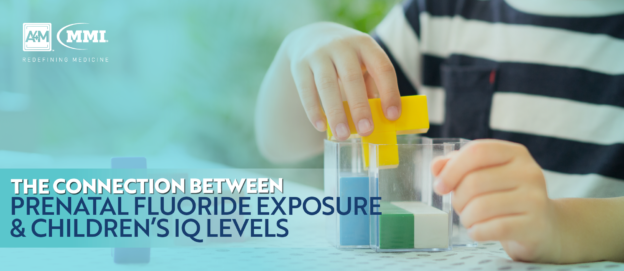The potentially noxious effects of fluoride are a highly contested subject within the medical community and the public arena as previous research has hinted at the possibility of detrimental health consequences caused by drinking fluoridated water ranging from dental fluorosis to neurotoxicity. As fluoride crosses the placenta – accumulating in the brain regions associated with learning and memory – it may alter proteins and neurotransmitters in the central nervous system of the fetus, making it potentially neurotoxic.
Although still a controversial subject, increased fluoride exposure from community water fluoridation has been tied to lowered children’s IQ levels in past studies, prompting growing research efforts aimed at uncovering the link between prenatal fluoride exposure and IQ levels in offspring. A recently published prospective study implicates that high fluoride intake during pregnancy may be associated with a reduction in children’s IQ at ages 3 to 5 years, and potentially beyond.
Association Between Prenatal Fluoride Exposure and IQ Levels in Offspring
The majority of previous studies on the noxious effects of fluoride intake were cross-sectional, conducted in regions with significantly higher concentrations than considered optimal, and did not measure exposure levels during fetal brain development. In order to assess whether maternal fluoride exposure during pregnancy was associated with childhood IQ levels, lead author Dr. Christine Till, an associate professor of psychology at York University, and colleagues conducted a multi-center observational study on a Canadian cohort receiving optimally fluoridated municipal water.
For their investigation, Dr. Till and her team enrolled a cohort of 601 women who had given birth between 2008 and 2012 in several cities across Canada: Vancouver, Halifax, Hamilton, Kingston, Montreal, and Toronto. Of the participant group, 41% lived in communities supplied with fluoridated municipal water. To determine fluoride concentration during each trimester, researchers collected maternal urine samples and self-reported data on intake of drinking water. Children’s IQ levels were tested using the Wechsler Primary and Preschool Scale of Intelligence-III between the ages of 3 and 4.
The study’s results, published in JAMA Pediatrics, found a median urine fluoride concentration of 0.41 mg/L; for women living in cities with fluoridated water the median concentration was significantly higher (0.69 mg/L). In children born to mothers exposed to higher fluoride levels, an additional 1mg/L of maternal urinary fluoride contributed to a decrease of 4.49 IQ points in boys and no statistically significant change in girls. On the contrary, a nonsignificant increase in IQ points was noted in girls with increased fluoride exposure.
The self-reported data gathered revealed no differences in IQ levels between sexes; among 400 women with complete self-reported data, each 1 mg/L increase was associated with a 3.66 decrease in IQ for both boys and girls. Overall median estimated daily fluoride intake was higher in women living in fluoridated areas at 0.93 mg/L.
Study Limitations and Controversy
Dr. Till’s findings implicate a potential association of fluoride exposure during pregnancy with adverse effects on childhood intellectual development, although critics emphasize the study’s limitations, cautioning against interpretation until additional research replicates these results. The subtle overall effect of fluoride exposure, limited only to male offspring, alongside unmeasured confounding variables should be taken into consideration when assessing the trial’s results. Further cross-sectional research is necessary to determine the validity of Dr. Till’s findings before any policy recommendations or revisions are made.
On the other hand, some experts praise Dr. Till’s methodology and emphasize the numerous potential threats to the validity of the findings that were carefully considered by the authors. The research team accounted for over 30 covariates and ran multiple sensitivity analyses to mitigate the limitations of observational trials, according to Dr. Till. Covariates included child sex, gestational age, age at testing, secondhand smoke exposure, quality of home environment, among many more medically relevant variables. Despite various experts having attested to the quality of the study’s analysis, there is evident controversy regarding the latest findings, which further underscores the dispute over community water fluoridation.
Fluoride Level Regulation
Largely utilized in the United States and Canada, community water fluoridation aims to reduce tooth decay and is supplied to approximately 66% of American residents, 38% of Canadian residents, but only 3% of European residents. Fluoride from water and tap water-derived beverages contributes to 60% to 80% of daily fluoride intake for residents of fluoridated communities.
In 2015, U.S. federal agencies re-evaluated fluoride guidelines which then allowed a maximum of 4 mg/L of fluoride in water. While Health and Human Services recommends 0.7 mg/L as an optimal fluoride level, the EPA deemed a dose of 0.8 mg/kg/day as “likely not harmful” in their re-evaluation. In its guidelines for drinking water quality, the World Health Organization limits fluoride levels to 1.5 mg/L, emphasizing the importance of considering geographic and environmental differences affecting water content. As such, there are no standardized or ubiquitously enforced regulations limiting the fluoride content of water across populations and while some public health officials believe in the negative health impact of excess fluoride, others do not find the scientific evidence conclusive.
At present, there are no specific guidelines on fluoride use in pregnant women, despite the years of controversy surrounding the issue. The latest findings implicate that fluoride exposure during pregnancy may have a detrimental effect on childhood intellectual development due to the mineral’s potential neurotoxic properties, suggesting the possible need to further re-evaluate current regulations and recommend reduced fluoride intake during pregnancy.
The study’s authors make no recommendations for water fluoridation policies and experts await forthcoming research supporting the latest evidence before alarming the public. Nonetheless, reverberations of the study’s findings are already noticeable with significant media coverage and growing debate over the issue. Although the implications of the trial are concerning, the study authors hope that their results will be used in conjunction with other recent studies to help inform future fluoridation policy changes.

